Serge Haroche
Our editors will review what you’ve submitted and determine whether to revise the article.
- Born:
- September 11, 1944, Casablanca, Morocco (age 79)
- Awards And Honors:
- Nobel Prize (2012)
- Subjects Of Study:
- photon
- quantum mechanics
Serge Haroche (born September 11, 1944, Casablanca, Morocco) French physicist who was awarded the 2012 Nobel Prize for Physics for devising methods to study the quantum mechanical behaviour of individual photons. He shared the prize with American physicist David Wineland.
Haroche received degrees in physics in 1967 from the École Normale Supérieure in Paris and a doctoral degree in 1971 from Université Paris VI (now Université Pierre et Marie Curie), where his adviser was French physicist Claude Cohen-Tannoudji. In 1972 and 1973 he was a postdoctoral fellow at Stanford University in California, where he worked in the laboratory of American physicist Arthur Schawlow. Until 1984 he was an assistant professor at the École Polytechnique in Paris (and from 1976, Palaiseau). From 1982 to 2001, he was a professor at the École Normale Supérieure, Paris. He was also a professor at Université Pierre et Marie Curie from 1975 to 2001 and a part-time professor at Yale University in New Haven, Connecticut, from 1984 to 1993. In 2001 he became a professor at the Collège de France in Paris, where he was chair of quantum physics. Haroche served as president of the college from 2012 to 2015, when he retired as professor emeritus.

Haroche’s work concentrated on studying individual microwave photons trapped between two mirrors. The photon trap was a cavity 2.7 cm (1.1 inches) in length, bounded by two curved superconducting mirrors. To detect the trapped photons, the experimenters projected atoms of rubidium that were in a superposition of two quantum states through the cavity, one at a time. As an atom crossed the cavity, its energy state was excited by the photon, and thus measurement of the atom’s state revealed the state of the photon without destroying it. In 1996 Haroche and collaborators succeeded in placing photons in a superposition of two quantum states. This allowed them to study quantum mechanical behaviour that had previously only been the subject of thought experiments, such as the famous Schrödinger’s cat. (In the 1930s German physicist Erwin Schrödinger, as a demonstration of the philosophical paradoxes involved in quantum theory, proposed a closed box in which a cat whose life depends on the possible radioactive decay of a particle would be both alive and dead until it is directly observed.) In 2008 Haroche and collaborators were able to observe the photons inside the cavity change from a quantum state to a classical state.


















